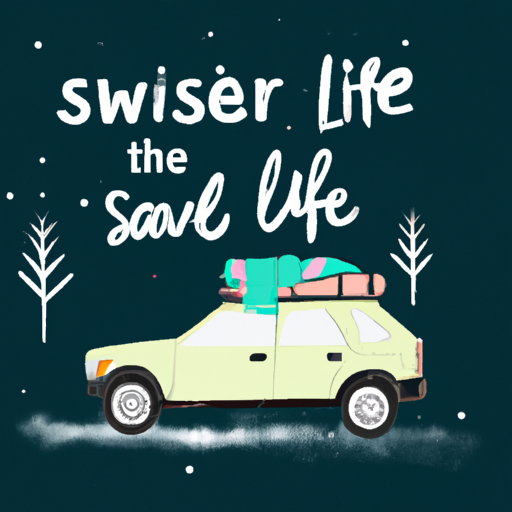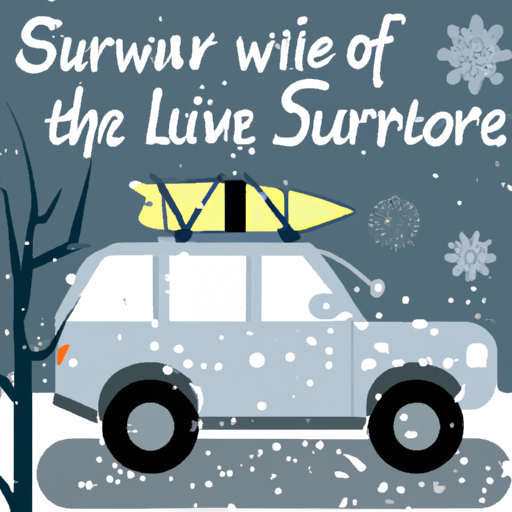Surviving Winter Behind the Wheel
Surviving Winter Behind the Wheel: A Comprehensive Guide
Surviving winter behind the wheel doesn’t have to be a daunting task. In fact, with the right approach and precautions, it can even be enjoyable. Here are some insightful tips and strategies to help you navigate the winter roads with confidence and ease.
Ensure Your Car is Well Serviced
Winter is arguably the most crucial time for full car servicing. This process involves checking and topping up fluid levels, inspecting the engine for any potential issues, and examining the tires. The service also scrutinizes all drive systems and brakes, ensuring your car is safe for the road. If any issues are identified during the service, make sure to address them promptly. This way, you’re not only surviving winter behind the wheel, but you’re also thriving.
Take Measures to Protect Your Car
Winter weather can be harsh on your car, causing scratches and chipping from stones. To avoid this, consider applying a ceramic coating to your vehicle. This coating helps keep your car clean during adverse weather, protecting it from scratches and other potential damage. Additionally, swapping to winter tires and adding mudguards can provide extra protection and peace of mind while surviving winter behind the wheel.
Stay Warm and Comfortable
Winter driving doesn’t mean you have to be uncomfortable. If you’re not a fan of driving in bulky winter coats, keep them within reach for when you step out of the car or in case of unexpected stops. Layering your clothing can also help maintain your comfort while ensuring you’re prepared for any weather changes.
Pack the Right Supplies
In your quest to survive winter behind the wheel, it’s crucial to pack essential supplies. These might include waterproof clothing, blankets, water, a thermos, maps, and even a first-aid kit. These items can prove invaluable in case of a breakdown or if you lose your way in unfamiliar terrain.
Keep Your Car Clean
While it may seem trivial, maintaining a clean car can enhance your safety on the road. A clean vehicle can boost your confidence behind the wheel and create a positive impression on other road users. They may perceive you as someone who values their vehicle, encouraging them to exercise more caution when around you.
Drive Slowly and Safely
Winter roads can be hazardous, requiring a more cautious approach to driving. This means leaving earlier for your journeys, even the shorter ones. While driving, give yourself ample time and space on the road to prevent accidents.
Plan Your Routes Ahead
To better survive winter behind the wheel, plan your routes using online maps. This allows you to gauge how the weather is affecting traffic and identify any hazards or road closures. With a well-planned route, you can navigate the winter roads with greater ease and confidence.
Surviving winter behind the wheel is all about preparation, caution, and a positive mindset. With these tips, you can turn what might have been a daunting task into a manageable, and even enjoyable, experience. Stay safe and happy winter driving!
| Tips for Winter Driving | Description |
|---|---|
| Get Your Car Serviced | Getting a full car service will ensure that your car is safe and ready to handle winter conditions. |
| Protect Your Car | Protect your car from harsh weather conditions and potential damage by using a ceramic coating and adding mudguards to your tires. |
| Wrap Up Warm | Always have warm clothing and layers in your car, especially for when you need to leave the vehicle or if you are forced to stop for any reason. |
| Pack Supplies | Always have essential supplies such as waterproofs, blankets, water, a thermos, and maps in case of a breakdown or getting lost. |
| Keep Your Car Clean | A clean car can boost your confidence and may encourage other drivers to be more cautious around you. |
| Take Your Time | Winter conditions can make roads more hazardous, so give yourself more time for journeys and be more cautious on the road. |
| Plan Your Routes | Check online maps before starting a journey to assess the weather’s impact on traffic and look for potential hazards or road closures. |

Understanding Winter Driving Conditions
When it comes to surviving winter behind the wheel, it’s important to understand the unique challenges that winter driving presents. The icy roads, reduced visibility, and unpredictable weather conditions can make even the most experienced drivers feel out of their comfort zone. Understanding these conditions can help you prepare and respond appropriately, ensuring a safer and more comfortable journey.
Ice and Snow on the Roads
Ice and snow can make the roads slippery, reducing traction and making it harder to control your vehicle. It’s crucial to drive slowly, brake gently, and avoid sudden movements that could cause your car to skid. Using winter tires can also enhance your vehicle’s grip on the icy roads, providing better control and stability.
Reduced Visibility
Winter weather can significantly reduce visibility. Snowfall, fog, and shorter daylight hours can make it harder to see the road ahead and other vehicles. Always ensure your headlights and windscreen are clean and working correctly, and consider using fog lights when necessary. Adjust your driving speed to suit the visibility conditions, and always keep a safe distance from the vehicle in front of you.
Adapting Your Driving Style
Surviving winter behind the wheel also involves adapting your driving style to suit the conditions. Winter driving often requires a more cautious and defensive approach to ensure safety.
Defensive Driving
Defensive driving involves anticipating potential hazards and making safe and well-informed decisions on the road. This can include monitoring the behavior of other drivers, giving way when necessary, and maintaining a safe distance from other vehicles, especially in adverse weather conditions.
Patience is Key
Winter driving can be frustrating, with slow-moving traffic and longer journey times. However, patience is crucial for safety. Rushing can lead to mistakes and accidents, so it’s important to remain calm, patient, and focused on the road.
Emergency Preparedness
Despite taking all the necessary precautions, emergencies can still happen. It’s important to be prepared for such scenarios when you’re surviving winter behind the wheel.
Emergency Contact Numbers
Always have a list of emergency contact numbers readily available. This should include roadside assistance, your vehicle insurance provider, and family or friends who can help in an emergency.
Car Breakdown Kit
In addition to the essential supplies mentioned earlier, consider packing a car breakdown kit. This can include items like a flashlight, jumper cables, tow rope, and a shovel to dig your vehicle out of the snow. You never know when these items might come in handy.
Learning Basic Car Maintenance
Knowing how to perform basic car maintenance tasks can be a lifesaver in a breakdown situation. This can include changing a flat tire, checking and topping up oil levels, and jump-starting your car. Consider taking a basic car maintenance course or watching online tutorials to equip yourself with these skills.
Surviving Winter Behind the Wheel: FAQs
What should I do if my car skids on ice?
If your car skids on ice, it’s important to stay calm and avoid sudden movements. Steer in the direction you want to go and gently pump your brakes to regain control.
How can I improve my visibility when driving in snow?
Improving visibility when driving in snow can involve using your headlights correctly, keeping your windscreen clean, and using fog lights when necessary. You should also adjust your driving speed to suit the visibility conditions.
What should I do if my car breaks down in winter?
If your car breaks down in winter, try to move it off the road if possible. Turn on your hazard lights, and call for roadside assistance. Use your emergency supplies and stay warm until help arrives.
Surviving winter behind the wheel is all about preparation, understanding the conditions, adapting your driving style, and being prepared for emergencies. With these tips, you can navigate the winter roads with greater confidence and safety. Happy winter driving!
FAQs
1. How can I ensure my car is ready for winter?
Ensuring your car is well serviced and prepared for winter includes checking and topping up fluid levels, inspecting the engine for issues, and examining the tires. Also, make sure all drive systems and brakes are functioning well. If any issues are identified during the service, address them promptly.
2. How can I protect my car from winter damage?
Protect your car from winter damage by applying a ceramic coating to your vehicle. This coating protects it from scratches and other potential damage. Also, consider swapping to winter tires and adding mudguards for extra protection.
3. How can I stay warm while driving in winter?
If you’re not a fan of driving in bulky winter coats, keep them within reach for when you step out of the car. Layering your clothing can also help maintain your comfort while ensuring you’re prepared for any weather changes.
4. What supplies should I pack for winter driving?
Essential supplies for winter driving might include waterproof clothing, blankets, water, a thermos, maps, and even a first-aid kit. These items can prove invaluable in case of a breakdown or if you lose your way in unfamiliar terrain.
5. How can I maintain safety while surviving winter behind the wheel?
Maintaining a clean car can enhance your safety on the road. Also, adopt a more cautious approach to driving in winter. This means leaving earlier for your journeys and giving yourself ample time and space on the road to prevent accidents.
6. How can I plan my routes during winter?
Plan your routes using online maps. This allows you to gauge how the weather is affecting traffic and identify any hazards or road closures.
Table: Checklist for Winter Driving
| Item | Description |
|---|---|
| Car Service | Ensure your car is in good working condition by having it serviced before winter. |
| Car Protection | Apply a ceramic coating to your car and consider swapping to winter tires for extra protection. |
| Warm Clothing | Layer your clothing and keep a winter coat within reach. |
| Supplies | Pack essential items like waterproof clothing, blankets, water, a thermos, maps, and a first-aid kit. |
| Car Cleanliness | Keep your car clean to enhance safety and boost confidence while driving. |
| Safe Driving | Drive cautiously, leave earlier for your journeys, and give yourself ample time and space on the road. |
| Route Planning | Plan your routes using online maps to identify any potential hazards or road closures. |

